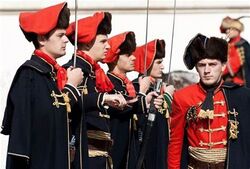Great Prince's Own Royal Thračician Foot Guard
The Great Prince's Own Royal Thračician Foot Guard (Burg: Peletons d'Elite Tharchicien della Gran Prince) is an ethnic Thračician guard demi-regiment in the direct service of the Great Prince of Burgundie. The Guard is a non-mechanized infantry demi-regiment tasked with the protection of the Great Prince, his family and possessions. It is one of the only permanent and active military unit in the Burgoignesc Metropole.
| Great Prince's Own Royal Thračician Foot Guard | |
|---|---|
| Peletons d'Elite Tharchicien della Gran Prince | |
 Thračicians on Parade under the review of Teniente Propietare Đureković | |
| Founded | 1623 |
| Country | |
| Type | Royal guard, light infantry |
| Size | 1,254 demi-regiment |
| Part of | Army of Burgundie |
| Garrison/HQ | Vilauristre, Ile Burgundie, Burgundie |
| Colors | red and black
sang et suie blood and soot |
| Commanders | |
| Propietare (COL) (Honorary) | Pasqual I |
| Teniente Propietare (LT COL) (Operational commander) | Dalibor Đureković |
| Notable commanders | Ljubomir Ivanišević (1684-1716) reThračicication of the unit |
| Insignia | |
| Guidon of the Great Prince's Own Royal Thračician Foot Guard | Guidon Great Prince's Own Royal Thrachician Foot Guard.png |
Today the unit is largely ceremonial with the majority of their duties performed at the royal residences. They have a small detachment of bodyguard personnel that also protect the individuals of the royal household and visiting dignitaries. While on ceremonial guard duty they wear their traditional Thračician uniforms and they are armed with a concealed MAG-17 and a ceremonial sword which they are trained to use in the event it becomes necessary. They are a combat capable light infantry unit specializing in urban warfare and hostage rescue and movement.
They currently number 1,254 strong with 827 guards, and the remainder assigned to HQ command and control, intelligence, counter-intelligence, or surveillance functions. When exercising and fighting they wear the same uniform and kit as the rest of the Army of Burgundie. They carry the SAR-99L as their main firearm, the MAG-17 as a sidearm.
Structure
History
Origin
The Guard originates from 1623 when Terentius, Archduke of the Sydonas pledged an honor regiment of 1,000 men to Fransois I, Duke of Bourgondi, as a dowery for his daughter's hand in marriage. This regiment was named "The Sydonian Band of Royal Footmen" (Burg: la Bande Sydonaise Peleton Real). For the first 60 years, these men were originally uniformed, trained, and used as standard Pike and shot infantry. In 1684 a new commander came from Sydona, Ljubomir Ivanišević, who wanted to make the unit more Thračician in its uniform and traditions. Under his command the unit adopted the uniform and tactics of the Thračicians of Sydona once again and they began to distinquish themselves. In a brilliant publicity move, he recommended to Duke Louis I that la Bande Sydonaise Peleton Real travel around the Holy Levantine Empire to showcase not only their skill about also their foreignness, as a demonstration of the Duchy of Bourgondi's global reach. This was a sensation at court and the Levantine use of Thračician mercenaries increased, though none proved to be as professional and effective as la Bande Sydonaise Peleton Real.
Heyday
In time, the regiment grew due to the increased use of Thračicians in Bourgondi's colonial ambitions and the regiment became a symbol of the good Sydonan-Burgoignesc relations. It took an active role in most Burgoignesc conflicts, both internal and external. Even after Sydona became a possession of Kiravia, a sworn enemy of Burgundie, the regiment remained though ties with Burgundie had been severed.
In the 1720s the band was deployed to the Colony of Santasi to try to stave off the encroachment of the Duchy of Marialanus in the Kandoori-Fana wars in modern day Kandara but were unable to stop the takeover of the colony, despite many heroic acts and heavy losses. They returned to the Duchy of Bourgondi and were reformed as two independent companies of palace guards. In the 1790s, back up at regimental strength, they were deployed back to Audonia to fight in the Great Rebellion of Slavery Bay, first in Pukhgundi colony 1797-1811, then Kandahari-Pukhtun colony 1811-1833, and finally Istroya Oriental colony 1833-1842. By the time they returned to the Duchy of Bourgondi permanently, two generations of soldiers had never been to the Ile Burgundie.
The Modern Guard
Due to decreased demand for full time soldiers in the Burgoignesc military, the number of soldiers being replaced in the Foot Guard has dwindled. At is peak in the 1840s the Foot Guard was 6,500 strong, but its current roster is merely 1,254. Since the Second Great War, in 1937, the unit was reorganized to also include Chrobonskians who serve in the unit until today. To honor the original agreement with the Thračicians the unit will retain its regimental designation, but currently operates at demi-regiment status.